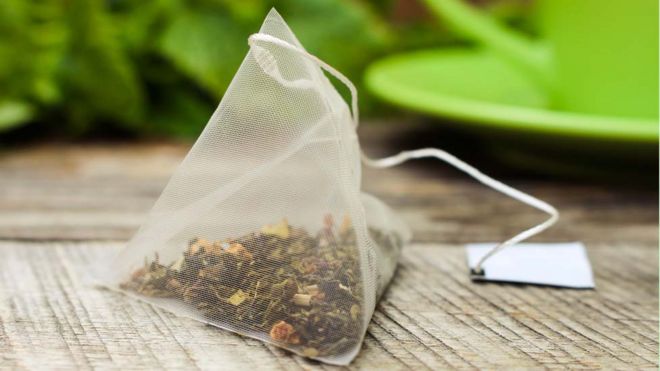Not In My Tea!
"I was not surprised to see there was plastic coming out. I was surprised to see such a high concentration."
"It would be a responsible consumer action ... to stop purchasing this ['silken' tea bag products], not only because of the plastic that it's releasing, but because of the single-use plastic."
"The consumer should avoid plastic packaging, not a specific brand, and definitely not the tea that comes inside. We encourage consumers to choose loose teas ... sold without packaging or other teas that come in paper teabags."
"There is really no need to package tea in plastic, which at the end of the day becomes single-use plastic. [And] which is contributing to you not just ingesting plastic but to the environmental burden of plastic."
Laura Hernandez, Researcher, graduate student, McGill University, Montreal
 |
| Getty Images |
New research out of Canada indicates high quantities of microplastics are likely to be present in a cup of tea if that tea was produced with the use of a premium product; tea leaves presented in 'silken' tea bags. Those bags are made of food-grade plastic. They may look good and the tea would needless to say taste very good, but the hidden menace is the burden of microplastics.
Ordinary tea bags made of paper are quite different from the 'silken' tea bags made of plastic. Visually they are pyramid-shaped on the theory that the shape allows the tea leaves within, additional expansion room. Once used for the purpose they're meant for -- to produce a cup of tea -- the bag is discarded just as is the paper type. The difference is that the Researchers discovered that 11.6 billion microplastic particles and 3.1 billion nanoplastic particles are released into the tea produced with the plastic-type tea bags.
"I said, 'Oh God, I'm sure if it's plastic it's, like, breaking down into the tea.'"Why the research on tea bags? Professor Tufenkji, it appears, ordered tea while at a coffee shop, then regarded the resulting liquid with astonishment. She was convinced she was seeing tiny bits of plastic floating about in the tea. That inspired her to think of this research. On return to her laboratory she spoke to her graduate student, instructing her to purchase various brands of tea in the plastic tea bags. Resulting lab tests revealed the presence of plastic particles, once the tea bags were steeped in boiling water.
"We were shocked when we saw billions of particles in a single cup of tea,"
"There's really no research [with respect to this issue]. But this really points to the need to do those studies. Think of people who drink one or two or three cups of tea a day, every day."
Nathalie Tufenkji, professor of chemical engineering, McGill University
On the evidence of Professor Tufenkji's brief experience, the two fully expected to see microplastic and smaller nanoplastic particles appear. They just weren't prepared for the huge numbers involved. The sheer number of contaminants from the tea bag seemed far in excess of such particles reported previously in other foods. Table salt has a fairly high concentration of microplastics, at 0.005 microplasgrams per gram of salt. In comparison, a cup of tea holds between 13 and 16 micrograms of microplastics, reflecting results for the four different tea bag brands the study tested.
 |
| Many fancier teas now come in 'silken' bags instead of paper, and some of them are pyramid-shaped, which is billed as a way to make room for the large leaves in premium teas to expand. (Shutterstock / slawomir.gawryluk) |
The study was published last week in the journal Environmental Science & Technology. According to the World Health Organization, little evidence exists to suggest that the presence of microplastics in drinking water represents a harm to human health. Further study is required before any alarm is raised. Differing dosages of nanoplastics and microplastics were used when the researchers at McGill "treated water fleas" and identified anatomical and behavioural abnormalities in the bugs which nonetheless did not die.
When the McGill team brought the different brands of plastic tea bags to their lab, they removed the tea leaves before testing, to ensure that the presence of the tea leaves would not interfere in their testing for plastic leaching from the bags. Rinsing the tea bags, they heated the water to simulate the brewing of tea, following which a process called electron microscopy measured the presence of minuscule plastics in the heated water.
To gain some perspective on size of the plastic, microplastic particles are equal to the diameter of a human hair, while a nanoplastic is roughly one thousand times more minuscule than that measurement. No evidence yet exists linking plastic particles ingested to health problems, mentioned both researchers, but consumers, they cautioned, would be well advised to exercise normal vigilance and avoid single-use plastic teabags.
 |
| In a preliminary experiment, water fleas exposed to the microplastics from the tea bags 'ballooned' and showed behavioural changes that suggested they were stressed. ((Paul D.N. Hebert, University of Guelph)) |
Labels: Experiments, Ingestion, Plastic Particles, Research, Science

0 Comments:
Post a Comment
<< Home